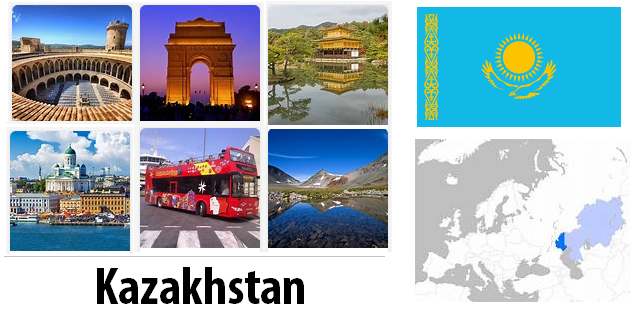Geography
Kazakhstan, between the Volga plain in the west and the Altai in the east, is the world’s ninth largest country and the largest landlocked country with more than 2.7 million square kilometers. The country is bordered in the north and west by Russia, in the south by Kyrgyzstan, Turkmenistan and Uzbekistan and in the east by China. The Caspian Sea is located in the southwest of Kazakhstan. The West Siberian lowlands extend to the north.
90% of the country’s surface consists of plains, hills and low mountains covered by steppes and deserts. In the north-west of Kazakhstan, the Mugojar Mountains rise, in the south-east are the mountains of the Tienschan and the Alatau, in the east are the forested foothills of the Altai Mountains, which separate Siberia from the Central Asian deserts.
The largest waters are the shrinking Aral Sea and the Balchaschsee.
In the western part of the country, the swampy area of the Caspian Valley lies below the sea level. Here is the lowest point in Kazakhstan, the Karagije valley (-132 m). Further to the east, the Caspian Valley merges with the Ustyurt plateau.
The Aral Sea, like the large deserts of the country (Kysylkum and Aralkarakum), is located in the Turanian Valley. The Kazakh threshold, characterized by semi-deserts and steppes, rises in the central part of the country. Numerous medium-sized mountains and mountain ranges rise here (including Ulutau, Kökschetau and Karkaraly). The Turgai Plateau is in the northwest of the Kazakh Threshold, and the West Siberian Plain in the north.
In the extreme south of Kazakhstan, in the border regions with Kyrgyzstan and China, there are several high mountain ranges, including Dungarian Alatau, Qaratau and one of the highest mountain ranges in the world, the Tianshan (in Chinese “sky mountains”). The highest point at 7,439 m is reached in Kirkisistan, the highest mountain on the Kazakh side is the 6,995 m high Khan Tengri.
Kazakhstan climate
Kazakhstan’s climate is continental with hot summers and cold winters. In the desert, the July temperature usually reaches around 32 °C and drops to around 15 °C at night. Due to the low humidity, the temperatures are not too unpleasant. In winter, temperatures reach around -9 °C during the day and drop to -15 °C at night. Higher locations have hardly any influence on the weather conditions, winters are hardly warmer and summers are hardly cooler. However, in higher altitudes there is more precipitation, especially in the east from April to May. Snow falls from November, the passes are covered with snow until April, sometimes even until May.
Best time to go to Kazakhstan
In hot summers and bitterly cold winters, spring (April to June) and autumn (September to October) are the best seasons to visit Kazakhstan. The desert blooms briefly in April and the monotonous landscape explodes in red, orange and yellow. Autumn is harvest time, during this time you can find freshly harvested fruit on the markets. If you choose to travel in winter, keep in mind that many domestic flights do not start due to weather conditions. In addition, many restaurants are closed in winter.
Money
Currency: 1 tenge corresponds to 100 tiyn.
Currency abbreviation: KZT (ISO code) – ABBREVIATIONFINDER.ORG
Banknotes worth 200, 500, 1,000, 2,000, 5,000 and 10,000 tenge are in circulation. Coins are used in amounts of 5, 10, 20, 50 and 100 tenge (more common) and 1 and 2 tenge (less common).
Exchange rate:
October 2009
1 US dollar = 153 tenge
1 euro = 225 tenge
1 Swiss franc = 149 tenge
Sightseeing
Kazakhstan has some great sights and attractions to offer. You shouldn’t miss the most important and most beautiful Russian Orthodox Church in the country. The St. Sophia Cathedral (also called Holy Resurrection Cathedral) is located in Almaty. It was built in Russian style in 1907 and is now the seat of the Bishop of Turkestan. The peculiarity of the church is that it was built entirely of wood. It is also one of the last buildings in Almaty that survived the last major earthquakes in 1911 and 1921 without damage.

The mausoleum and mosque complex Chosha Achmet Jassawi in the city of Turkestan is also worth seeing. The unique cultural monument dates from the 14th to 15th centuries. Century. The building complex consists of more than thirty halls grouped around the main hall, the Kazanlyk. The central hall is covered with the largest pointed-arched dome in Central Asia. The dome has a diameter of more than 18 meters.
Kazakhstan has special buildings to offer, particularly in the capital Astana, which is still under construction. A unique architectural ensemble can be seen here, especially for Central Asia.
There was a lot of new construction, ministries, embassies, residential buildings, hotels etc. in a largely bombastic architectural style. The architects of the new city were found through an international architectural competition involving architects from all over the world.
